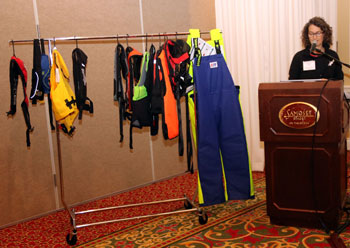Fishermen’s PFD Choices Shown
at Forum

Rebecca Weil discussing the latest Person Floatation Devices that fishermen had trial tested and commented on in the past year. Mark Haskell photo
Two items at the three-day Fishermen’s Forum in Rockport were Personal Flotation Devices (PFD) and the Maine Lobstermen’s Association’s new black T-shirt with “Fish Smarter, Not Harder” in white on the back.
Rebecca Weil from the Northeast Center for Occupational Safety and Health and John McMillan of McMillan Offshore Survival Training presented several versions of new PFD designs. Weil has been involved with a program to engage fishermen in the design and experimental use of PFDs in New England. McMillan is a 20-year veteran of offshore survival and marine safety training.
The new PFD evolved out of the bulky versions of flotation devices and life jackets that have been Coast Guard-required for many years. However, these were typically stored onboard to be available in the event of an emergency. The new technology and designs have sought to produce a PFD that is comfortable enough to be worn as easily as a bib, boots or hat. An important design hurdle was making the PFD in such a way that it was not interfering with the work fishermen do. Snagging on traps while moving them, restricting arm motions or bulkiness that would be a constant presence had to be designed out.
Input from the fishermen who used the experimental devices led to significant improvements by designers and manufacturers. McMillan knew what fishermen wanted in a PFD that they would be wearing all day. He also knew what a PFD needed to do for a fisherman suddenly thrown overboard. Modern PFDs are immediately and automatically inflated in water. Some have EPIRBs attached, which send a signal and GPS coordinates.
The most noticeable difference in some new versions is that they are thin, narrow and lightweight. All of which makes them easy to become used to wearing. More like a pair of suspenders than the orange-fabric-covered blocks of flotation that were stored down below.
Below is an excerpt from the letter the Northeast Center for Occupational Safety and Health sent to the 181 lobstermen who participated in the trial use of lifejackets over the past year.
• Lobstermen selected eight models of lifejackets to be trialed, with a ninth one added after numerous requests.
• Lifejackets in the study were a wide range of styles and types, from buoyancy aids to offshore lifejackets.
• 181 lobstermen agreed to trial the lifejackets in Maine and Massachusetts during the winter and summer seasons.
• Participation in the study has been impressive, with a recruitment rate of 90.5% and a study completion rate of 88.4%.
We have learned a great deal from all of you about the challenges of wearing a lifejacket while fishing. Given the long days on the water hauling traps, and concerns about gear entanglement, you have indicated that a lifejacket should be:
• Comfortable, flat/not bulky, with no straps or buckles to snag, easy to clean, easy to use, bright in color, and for many – integrated into something already worn.
Included in this report are the peer reviews of the nine models. We anticipated that one or two lifejacket designs would be considerably more popular and address most of the barriers to regular use. Instead, we found that personal choice featured strongly in the results. While the ratings of all nine PFDs were generally favorable, what is clearly most important is finding what you can, and will, wear comfortably while working. The best lifejacket is a lifejacket that you will wear consistently.
